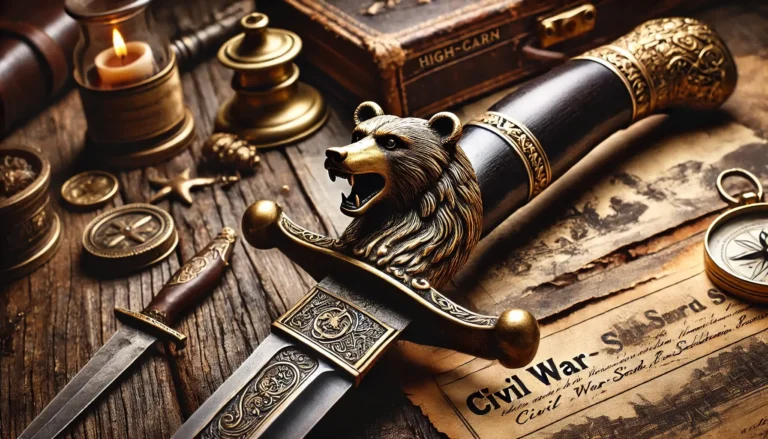The hongen civil war sword with bear face on handle is a fascinating historical artifact that has intrigued collectors, historians, and antique weapon enthusiasts. This sword, believed to be from the Civil War era, stands out due to its unique craftsmanship and symbolic design. The bear face on the handle suggests a deeper meaning, possibly related to strength, bravery, and leadership.
In this article, we will explore the origins, historical significance, craftsmanship, and collectibility of the hongen civil war sword with bear face on handle, shedding light on why it remains such a sought-after relic today.
The Origins of the Hongen Civil War Sword
While the name “Hongen” does not appear in many official Civil War records, there are several theories about its origins. Some experts believe it refers to a lesser-known manufacturer or a specific style of sword produced during the mid-19th century. Others speculate that “Hongen” might be a collector’s term or a reference to a particular unit or soldier who carried the sword.
The hongen civil war sword with bear face on handle is thought to have been used primarily by officers or high-ranking individuals. During the Civil War, swords were more than just weapons—they were symbols of authority, status, and honor.
The Unique Bear Face Handle Design
One of the most intriguing aspects of this sword is the bear face carved into its handle. The bear is often associated with strength, courage, and protection in various cultures. In the context of the Civil War, it might have represented:
- Bravery in battle: Soldiers often carried weapons that symbolized their personal or unit values.
- Leadership and power: The bear could signify dominance and resilience.
- Protective charm: Some believed that animal motifs on weapons provided spiritual or supernatural protection.
The hongen civil war sword with bear face on handle is one of the rare examples of artistic expression in military weaponry, blending both function and symbolism.
Materials and Craftsmanship
Swords of the Civil War period were crafted with great precision. The hongen civil war sword with bear face on handle was likely made with:
- High-carbon steel blade: Strong and durable, designed for combat and ceremonial use.
- Brass or bronze handle: Often used for decorative elements and grip durability.
- Intricate engravings: Many Civil War swords featured detailed etchings and patterns.
The attention to detail in the bear face carving suggests that the sword was custom-made or specially commissioned, making it a unique collector’s item today.
Role of Swords in the Civil War
While rifles and cannons were the primary weapons of the Civil War, swords still played a crucial role, especially among officers. The hongen civil war sword with bear face on handle may have been used for:
- Ceremonial purposes: Officers often carried finely crafted swords for parades and official duties.
- Close combat: Though rare, swords were used in hand-to-hand combat when firearms were not an option.
- Symbol of rank: High-ranking officials and cavalry officers carried swords as a sign of authority.
The presence of an ornate bear design suggests this sword was likely owned by someone of importance rather than a common foot soldier.
The Rarity and Collectibility of the Hongen Civil War Sword
Today, the hongen civil war sword with bear face on handle is considered a rare and valuable artifact. Its unique design, combined with its historical significance, makes it highly sought after by collectors and historians.
Factors That Affect Its Value:
- Condition: Well-preserved swords with minimal rust or damage are worth more.
- Authenticity: Verified Civil War-era swords command higher prices.
- Provenance: A sword with a documented history or link to a famous officer increases in value.
- Unique Features: The bear face handle makes this particular sword stand out among other Civil War weapons.
Collectors often seek swords like this because they represent both historical craftsmanship and personal stories of the past.
How to Identify an Authentic Hongen Civil War Sword
If you’re looking to purchase a hongen civil war sword with bear face on handle, here are some tips to ensure authenticity:
- Check the materials: Civil War-era swords were made of high-quality steel and metal alloys.
- Look for engravings: Many swords had unique markings that indicate their origin.
- Consult an expert: A professional appraiser can verify the authenticity of antique weapons.
- Compare with historical records: Some swords have documented histories that can be cross-checked.
Since the term “Hongen” is not widely recognized, it’s important to be cautious of reproductions or misleading labels when buying such artifacts.
The Legacy of the Hongen Civil War Sword
The hongen civil war sword with bear face on handle remains an iconic piece of history, capturing the artistry, symbolism, and personal stories of the Civil War era. Whether it was carried by a brave officer or served as a ceremonial weapon, this sword represents the spirit of resilience and strength that defined one of America’s most significant historical periods.
Collectors and historians continue to seek out this mysterious sword, keeping its legacy alive for future generations. If you ever come across one, know that you are holding a rare piece of history in your hands.
FAQs
1. What is the Hongen Civil War Sword with Bear Face on Handle?
It is a unique Civil War-era sword featuring a carved bear face on the handle, symbolizing strength and bravery.
2. Was this sword actually used in battle?
While swords were mainly ceremonial during the Civil War, some were used in close combat, especially by officers.
3. What does the bear face on the handle symbolize?
The bear symbolizes power, courage, and protection, possibly serving as a good-luck charm for the sword’s owner.
4. How can I tell if a Hongen Civil War Sword is authentic?
Authenticity can be verified through material analysis, engravings, expert appraisals, and historical documentation.
5. Is the Hongen Civil War Sword valuable?
Yes, due to its rarity and unique design, it is highly collectible and can be quite valuable to antique weapon collectors.

